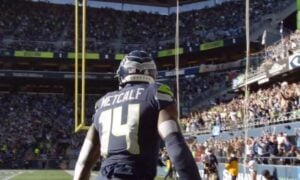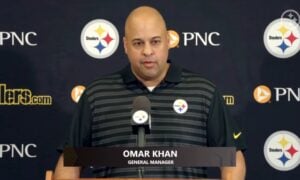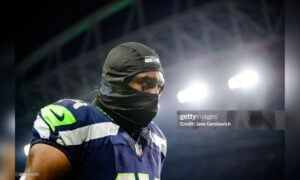Back in January, the Pittsburgh Steelers signed QB Dwayne Haskins to a one-year futures contract after being released by the Washington Football Team earlier in the season. The deal for Haskins was for the league minimum and has been deemed as a reclamation project of sorts by members of the media after being ousted by Washington. Erratic play and immature behavior led to the release of Haskins, as he managed to have his team captain status revoked in December after being seeing parting at a strip club without a mask and was subsequently fined $40,000 for the offense. He was regularly late to team meetings and seemed to not relish the duties necessary to be a starting NFL QB. After a poor showing against the Panthers the following week on the stat sheet, Haskins was benched in the fourth quarter and was then cut by the team four days later.
The problems with Haskins’ game have been well-documented by the national media and other members here on Steelers Depot. Outside of maturity issues, Haskins has clear problems with on-field awareness and decision making when it comes to delivering accurate passes on a consistent basis. Often times we would see him try and throw a ball into tight coverage, trying to rely on his arm strength rather than make a the correct read and get the ball to an open receiver. He also had other instances, like the play below versus the Browns in the preseason, where he flat out didn’t read the coverage and threw up the ball for the defense to make a play and get the turnover, in this case taking it to the house.
With this being said, I wanted to more of a deep dive into what Haskins did well during his time in Washington and decipher how he could potentially fit into the Pittsburgh Steelers’ offense going forward. We can first start with his calling card: arm strength. To be frank, the guy has a hose of an arm that can launch it to nearly every quadrant of the field with power and velocity on his throws. Ben’s comments of Haskins being able to throw a ball through a car wash and not get the ball wet during OTAs do stick out on a couple of these plays. For example, in the same game he threw that pick six against Cleveland, we see Haskins throw this beautiful ball from the pocket to the sideline overtop of the defender coming in to undercut the route from the safety position, allowing his receiver to high point the football and make a play. However, after the receiver catches it and attempts to gain more yardage, he fumbles it away to the other team.
In the same game we see Haskins execute the play action boot rollout to the right side of the field, making the throw on the run with his pass having impressive velocity for not having his feet set. The ball travels nearly 35 yards and lands in the receiver’s hands running to the sideline.
Haskins showed the ability to make a variety of the throws while on the run or evading pressure from the pocket, something he had to do quite frequently during his time at Washington. While not a phenomenal athlete in terms of speed and explosiveness, he does have the ability to maneuver the pocket well and roll out of the pocket when he senses pressure to step up into the pocket to deliver a key throw. Don’t believe me? Check out this TD pass against the Bengals where Haskins gets the snap out of the shotgun and immediately sees pressure come up the middle and on the edge. He manages to keep his eyes downfield and sets his feet, delivering a strike 45 yards in the air to his receiver who catches the ball in-stride and walks into the end zone for the touchdown while Haskins is wrestled to the ground. You could criticize Haskins for not stepping into his throw potentially, but with the pressure in his face, there really wasn’t anywhere to step up into. Plus, this clip is another example of the superb arm strength Haskins possesses to make this play.
Haskins’ ability to maneuver the pocket and make something happen out of nothing is kind of reminiscent to a younger version of Ben Roethlisberger when he came into the league given their size and play style as gun slingers out in the Wild West. This is in no means a direct comparison for Haskins to Ben, but rather an observation to the way Haskins can make things happen out of structure. Here is one example where the play breaks down against the Panthers, but Haskins shows the ability to avoid pressure, moving the right and then back to the left while making multiple defenders miss and throwing a catchable pass on the run without his feet set to his TE. Jeremy Sprinkle ends up dropping the ball, but the play shows that Haskins has the sense to escape pressure and give his receiver a chance to make a play on the football.
Now here is a treat. We talk about Haskins’ arm strength and ability to move in the pocket, but constantly hear he is incapable of delivering accurate passes downfield. While his completion percentage past 20 yards isn’t good to say the least, I disagree that he can’t connect on deep shots due to being incapable. Case in-point here on this play against the Jets where Haskins is forced to step up in the pocket on the play action pass, avoids pressure coming from his right, and manages to create enough torque with his arm on this side arm pass as he squares up to make the throw on the run, launching the ball nearly 55 yards in the air and having it in the breadbasket of #17 Terry McLaurin in-stride as he picks up more yardage after the catch and gets the ball in the red zone. This play shows off the true arm strength of Haskins to make a throw that Patrick Mahomes and recent draftee Zack Wilson have get lauded for in a game situation, but also his ability to put the ball accurately on his receiver down the field when off-platform. It would be hard-pressed to think that Ben as this point in his career or Mason Rudolph would have the arm talent or ability to maneuver out of the pocket to make the same play that Haskins makes here.
Another example in the same game of Haskins avoiding pressure and stepping up into the pocket to find his target downfield and deliver an accurate strike. Notice how Haskins keeps his eyes downfield the entire play and steps into his throw despite taking a shot in the back by #33 Jamal Adams, showing the poise under pressure you need to see from your signal caller.
Haskins gets a lot of flak for telegraphing throws with his eyes honed in on one target, making it easy for defenses to cheat and play the pass. While this does happen more than you like to see, we do have to understand that Haskins is only 24 years old and is still adjusting to the NFL game after playing in a wide-open offense at Ohio State. Here is a good example of Haskins using his eyes well to make the defense believe he is going to the RB in the flat but throws the ball to his receiver coming across the middle on the in-braking pattern. Once again, Haskins sees a good play end with his receiver dropping a ball that right into the breadbasket to the turf.
Now let’s watch this three-play sequence at the end of the half against the Panthers during Haskins’ rookie season. This first play we see Haskins make the play on the out route, showing the strength and velocity to zip the ball in there 15 yards on-target to #15 Steven Sims running to the sideline and catching the ball before going out of bounds. The deep out route is often considered the most difficult throw to make in football, and while Haskins could have done a better job stepping into his throw instead of humming it in with arm, he delivers an accurate strike to Sims to keep the chains moving.
Next, Haskins takes the snap of first down and drops back, keeping his eyes downfield as he steps up in the pocket to avoid the rush coming on both edges and steps into his throw with a defender in his face, putting the ball on his man in tight coverage to move the sticks and get into field goal range.
The next play, we see Haskins take the snap out of the shot gun while singling the pre-snap jet motion, dropping back and finding his running back coming out of the backfield on the right side and puts the ball on him with #25 Eric Reid coming in from overtop to try and break up the pass. The ball is thrown in-between three defenders in the area and put Washington well within field goal range. However, the kicker would miss the attempt, ending what was a successful two-minute offensive drive to end the half.
As I mentioned earlier, Haskins should not be considered a high-caliber athlete at the QB position when compared to the likes of Kyler Murray or Lamar Jackson as a runner. However, he should be considered immobile as well, as we have seen his ability to maneuver inside and outside the pocket as a passer to evade pressure. He also has the ability to pick up yardage with his legs on the ground, having decent open field speed and a big frame to be a threat to scramble out of the backfield. Like on this example against the Browns where Haskins drops back to pass, but pressure gets to him almost immediately, so he tucks the ball and scrambles up the middle, picking up first down yardage as he wisely slides down to avoid taking a big hit.
Another interesting wrinkle in Haskins’ game is his ability to execute to option as a legitimate threat to run the football. It would be hard to envision Ben keeping the ball after faking the handoff to Najee Harris and scampering upfield, but Haskins has the experience doing so, albeit on a limited basis. An example here against Cleveland where he carries out the fake handoff and takes off for a nine-yard gain on the play. While his open field speed isn’t spectacular, I would argue that it is better than what Ben and Rudolph currently bring to the table, although still not at Josh Dobbs’ level. Still, given the pre-snap motions and new concepts OC Matt Canada plans to install to revamp the run game, Haskins can be a player to adequately execute these option plays and be considered a threat to keep it and run, making the defense have to commit a player to him and away from the running back.
Overall, I came away impressed with various aspects of Haskins’ game compared to what I had previously seen and heard from national media circles deeming the young man a clear bust. Sure, there is no denying that he flamed out in Washington due to lack of preparation as a signal caller and inconsistent play that you need to have in order to be a successful starting NFL QB. However, while Haskins must obviously shoulder some of the fault, he did have a lot working against him as well as highlighted by playing with an inconsistent receiving core outside of one Terry McLaurin as well as being put constantly under pressure during his rookie and sophomore seasons in the league which should be devoted to development and surrounding a young QB with the pieces to be successful. I don’t think Washington did a good job of that, setting up Haskins to see adversity and failure, and his inability to execute lead to his eventual benching.
For comparison sake, we saw the likes of Sam Darnold struggle to achieve consistent play behind a poor supporting cast in New York, and the team elected to trade him to Carolina where he’ll have the chance to start and resurrect his career with a bunch of offensive weapons he didn’t have with the Jets. We see the Giants commit to Daniel Jones after a poor 2020 season, having addressed the offensive line the year prior in the draft and added multiple weapons this offseason to give him the best chance to be successful in a likely prove-it season.
The point I’m make is, why are we so convinced that these two signal callers who have underwhelmed thus far in the NFL are considered clearly better talents at the position than Haskins, who quite frankly, dealt with the same adversities, if not more, than they did? This is not a ringing endorsement saying that Haskins is going to be the savior in Pittsburgh. He has a lot of inconsistent play and bad decision making on tape that needs to be worked on to have confidence to roll out there as a starter. However, I do acknowledge the talent the man possesses and the instances where he has shown us that he has the qualities to be a capable starting quarterback in the league. From a scouting perspective, I have always been told “Don’t ask yourself what a prospect can’t do. Ask yourself what they can do.”
Now, if this same process holds true, we see a player that can do a lot of things you like to see for an NFL quarterback. The nice thing is, Haskins isn’t in the position where he has to experience “trial by fire” in Pittsburgh like he did in Washington. He is in a position, much like Patrick Mahomes, Aaron Rodgers, and others have been where he gets to basically take a redshirt year and fully learn the system and study how a pro handles the game in watch Ben play before ever being thrown out there. While you can say the offensive line isn’t anything special like it was in Washington, there is no denying that this would be the best set of skill players Haskins has been around since entering the NFL, and relieving some of the lofty, instant expectations on a young player with only two years of playing experience may be the breath of fresh air needed to hit the reset button and get his development on-track.
After doing this deep-dive, barring some unforeseen maturity relapse this season, I expect Haskins to make the roster and likely serve as the third-string option for the 2021 season. Given the natural of his RFA status, Pittsburgh shouldn’t have a problem resigning him to a cheap deal should he make it the season, putting him squarely in position to compete with Mason Rudolph for the starting job in 2022 if Ben hangs it up. Pittsburgh could elect to draft their future signal caller early, but should Haskins show them they may have something combined with Rudolph providing confidence as a gap year option as well, the team may elect not to go QB and instead address other possible glaring holes on the roster that I mention in my 2022 Steelers roster article. This would give the team the ability to have likely the solid floor but low ceiling of Mason Rudolph and the lower floor, but higher ceiling option of Haskins try and win the job.
There’s no doubt Haskins left a sour taste in the mouth of many who have watched him in his most recent action, but I am here for the “reclamation project” to capitalize on the talent he has and flashes he put on him to prove he deserves to make the roster in 2021 and potentially beyond.
What are your thought on Haskins and his outlook for the 2021 season and in the future? Do you think he can earn a second chance to start in the league, or that he is a lost cause and shouldn’t be considered more than a potential backup option moving forward? Please share your thoughts below in the comments and thanks again for reading and all of your support!








